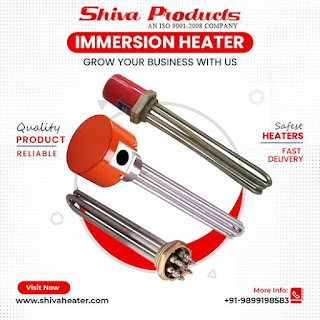All Things About Immersion Heater and It’s Varied Uses
One of the heaters known as the Immersion Heater is very much in demand today as it has multiple uses also. A tank or container with a heater attached can be used to heat any liquid to the desired temperature. Over-the-side, flanged, or threaded mounting options are all possible. As a versatile and cost-effective heating solution, heaters are available in various sizes, shapes, materials, and operating temperatures.
What is an immersion heater?
The
electrically heated water can be obtained through a heater. It employs a
heating element submerged in a cylinder of water; after the water reaches the
desired temperature specified by a thermostat, the cylinder shuts off, and the
water stays hot for a few hours.
Let's
explore precisely how a heater works and the best techniques to keep the costs
down should you decide to use one.
It may be
more cost-effective, depending on the age of your boiler, to replace it with a
new hydrogen-ready combi boiler rather than install an heater in response to the recent increase in
gas prices. Switching from a G-rated boiler to one of these A-rated boilers
will save you up to £580 annually in energy costs.
Not only
will this save you money, but these gas boilers can run on up to 20% hydrogen
fuel, and natural gas also ensures they can withstand the gas boiler ban in
2025.
To what degrees may an heater be used?
Immersion Heater suppliers in India offers wide selection of heaters to choose from. Hence the supply voltage
and resistance determine the maximum temperature heater may produce. Commercial
heaters can heat water to about 482°C (900°F). Since the resistance measurement
of the heater is constant, so is the heat output, regardless of the environment
or the application.
When would you use an immersion heater?
Different
heaters are better suited for various tasks. Immersion Heater is used to warm a wide variety of liquid and
viscous fluids, including water, oils, solvent, plating baths, salts, and
acids.
Following are some of the most typical uses for various heaters:
· Heaters
installed over the tank's side are ideal when a large work area and portability
are required, such as when the heater and tank must be removed for cleaning.
· Flanged
heaters, which come in various wattages, heating outputs, flange diameters, and
ratings, are an excellent solution for any tank, vat, or vessel with an unusual
shape.
· Process
water can be heated and kept from freezing with the help of a screw-plug
heater. These portable heaters are simple to operate and suitable for heating a
wide variety of oils and heat transfer solutions. Since it doesn't require any
additional equipment, the direct immersion method saves on both time and power.



Comments
Post a Comment